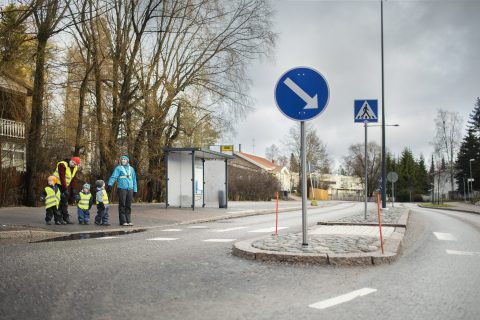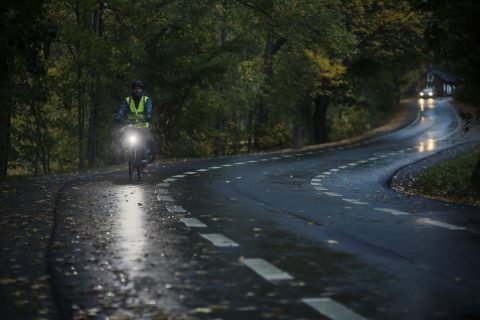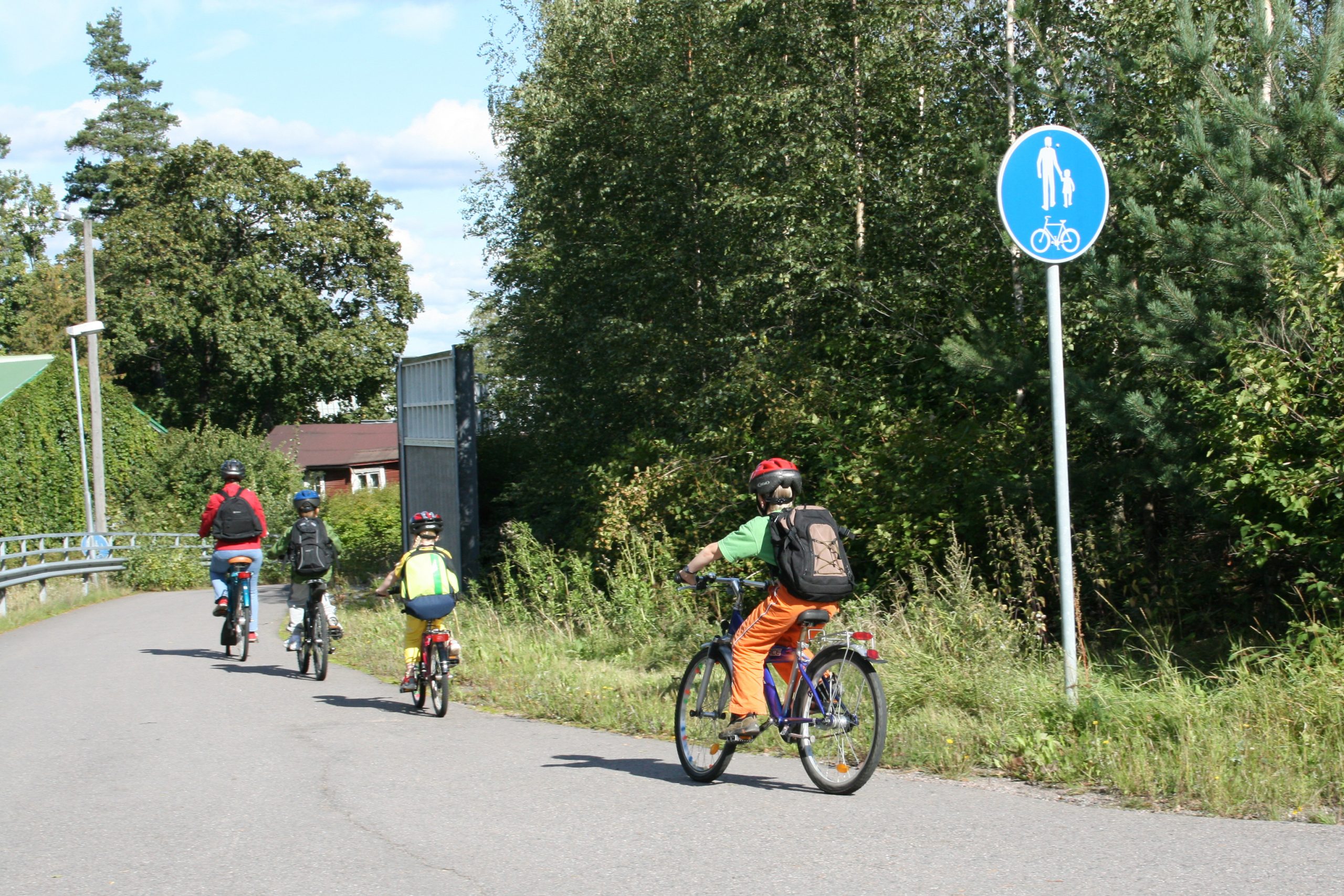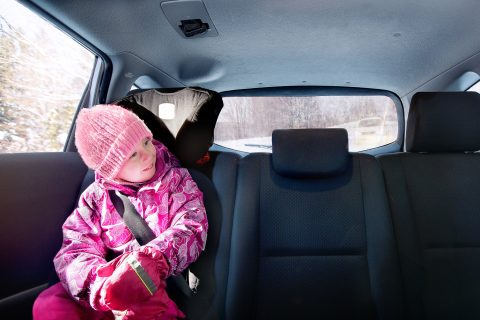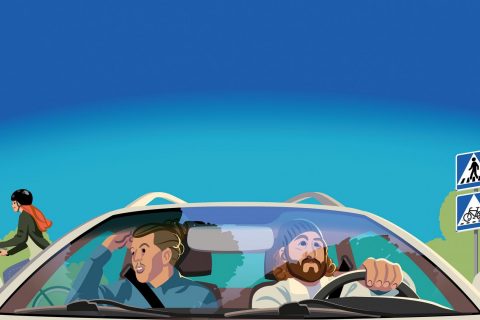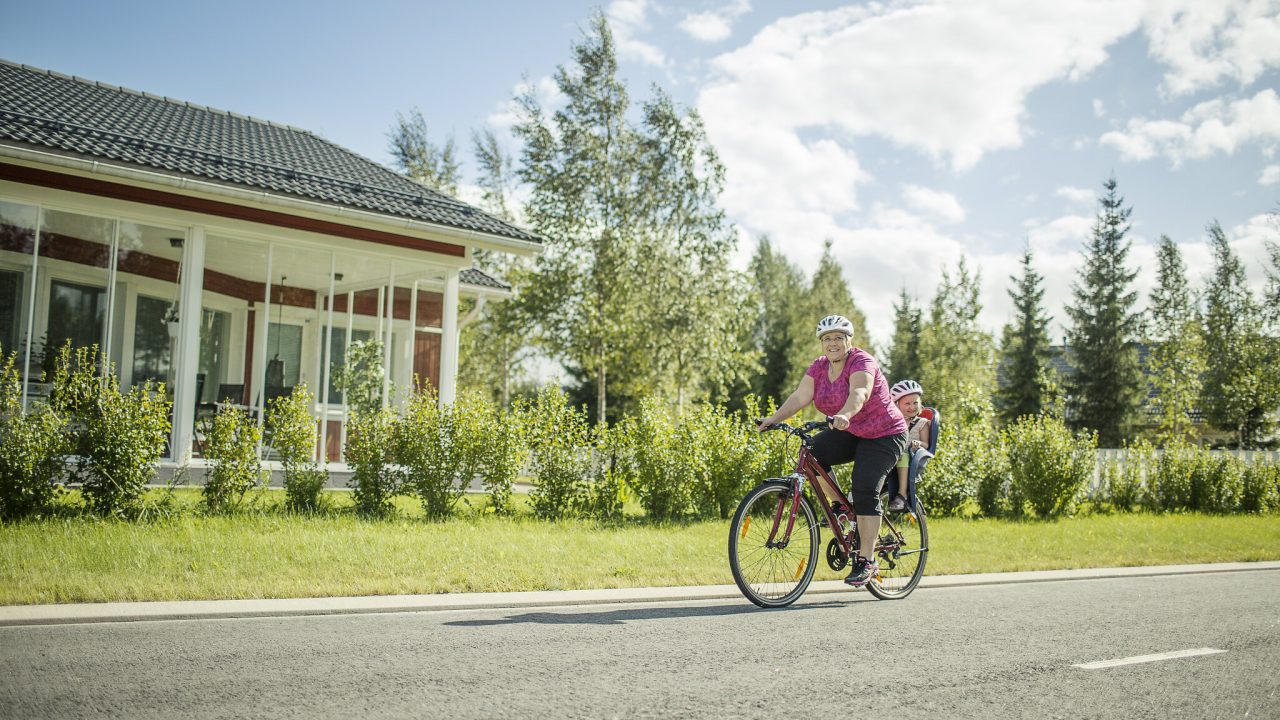
Carrying a child on a bike
There are various ways to cycle with children before they start to pedal themselves. Carrying a child on a bike can be done in a bike seat, trailer or cargo bike. A proper child seat prevents the child from falling off and prevents the child´s feet from touching the tyres or spokes.
The most common way of carrying a child on a bike is in a rear child bike seat. Bicycle trailers or other pullalongs can carry one or two children depending on the structure of the trailer. Cargo bikes can carry multiple children at the same time. The exact number of passengers depends on the type of the cargo bike.
The driver should check that the child is seated securely and as comfortably as possible. Read the instructions of the child seat or trailer, and secure it according to the instructions. Check that the attachments are secure again when seating the child. The seat belts help the child stay securely in place during the ride. Make sure that the child’s hands or feet cannot touch any moving parts of a bike.
Helmets protect the heads of adults and children in the event of an accident. Make sure the helmet is a good fit and worn properly, with the forehead protected.
Remember that carrying a child on the bike or a trailer may affect the driving characteristics, the braking distance and the vehicle’s stability. Even if you’re a regular cyclist, it is recommended to safely practice without the child and get used to the effect an extra load has on your stability, braking and riding style before you take a child passenger on board.
What the Road Traffic Act says about transporting children on bicycles
According to the Road Traffic Act, if you are carrying a child less than 135 cm tall on a bike or in a trailer, a seat suitable for carrying a child must be used. The Road Traffic Act requires two separate brake devices if the bicycle carries a passenger. When carrying a passenger in a trailer, there must be two separate brake devices on the bicycle and at least two wheels with brakes in the vehicle combination.
The structure of the bicycle determines the maximum load and the number of passengers. The maximum load is specified in the bicycle manual. It is also advisable to check the maximum load of the rack if the seat is to be attached to it. The Road Traffic Act does not specify age limits for the driver or the passenger, or any maximum loads.
Check the main traffic rules for cycling from our guide On foot and by bike (pdf) (Opens in a new window).
Tips for using a child seat or trailer:
- Read the instruction manual for fitting and using your bike seat or trailer. Remember to check the height and weight limits.
- Attach the seat or trailer carefully to the bicycle. Check that it is secure before each journey.
- Make sure that the bicycle stays upright when putting the child in the seat. A two-forked stand provides good support.
- Make sure your child is properly strapped in and that the child’s hands or feet don’t come into contact with any moving parts. Check that there are no loose straps, scarves or toys that will interfere with the mechanisms of your bike.
- Make sure the child is protected from weather. As the child will be sitting still, they will usually need warmer clothing than the driver.
- Put the helmet on the child before seating them and also wear a helmet yourself.
- Pay attention to other loads as well: a backpack may be uncomfortable for the child sitting behind you on a child seat. Think about opting for a basket or bike bags instead.
- Check the condition of the seat or trailer periodically, and service it when necessary. When the bicycle is in good condition, journeys are safer and more comfortable for both the driver and the passenger.
- Be proactive on the road. A steady ride is more comfortable for the child.
Bicycle child seat
A child seat secured on top of the rack is probably the most conventional and popular way of transporting a child on a bicycle. The standard for bicycle child seats (EN 14344) applies to seats for children from 9 kg to 22 kg. Children can ride in a rear-mounted child bike seat when they can sit well unsupported and when they are able to hold their head upright so that their necks are strong enough to support a lightweight helmet.
A child seat should be chosen so that the child’s weight and height match the manufacturer’s guidelines. The seat width should accommodate thicker clothing in cold weather, and its length should allow even smaller children to bend their knees in order to properly support their feet. The height should allow the securing straps to come over the shoulders, so that the child is supported when leaning forward. The back rest should support the child’s head when leaning back.
Though a child seat can be fitted on most bikes, check your bike’s manual to see if there is any restrictions and what is the maximum load capacity.
Bicycle trailer or cargo bike
There are different sizes of trailers for bikes. They can carry one or two children. Check before purchase whether the trailer can be attached to your bicycle model. Trailers may come with various accessories so that they can be used as a walking or running buggy. A hooded trailer protects the child from rain and wind.
The trailer is usually easy to attach and remove. Read the trailer’s manual and safety instructions before using the trailer.
The standard for bicycle trailers (EN 15918) applies to trailers that can carry one or two child passengers. The standard specifies that passengers should be able to sit independently and that neither of the passengers should weigh more than 22 kg. According to the standard, the maximum weight of a bicycle trailer with load is 60 kg, and the trailer must be equipped with a parking brake. The trailer must also have a suitable seat for a child and protective equipment to prevent the child from touching moving parts or falling off. A seat belt keeps small child passengers safely in place during a journey. Trailers that conform to the standard are equipped with a triangular flag made of orange high-visibility material.
Cargo bikes are available as two- or three-wheel models. Electric assistance makes the ride easier, especially when carrying more than one child. You can carry more than one child on a cargo bike as long as each of them has appropriate seating and there are two separate braking devices. Seat belts keep children safely in place on cargo bikes.
Carrying small babies by bicycle
Child restraints systems or babyseats designed for bicycles are hard to find. Someone may use child seats that are designed for cars and attach such a seat to the body of the cargo bike, for example. No standardised systems exist for securing babyseats to bicycles, and there is no research data on the suitability or safety of such mechanisms. There is also concern about how the shaking of the bicycle affects the baby and whether it is comfortable to them.
Service life of bicycle child seats
The service life of a bicycle child seat or trailer depends on the recommendations of the manufacturer, how frequently and in what conditions the seat is used, whether the seat is exposed to cold, heat, sunshine, etc. In terms of visual inspection, discolouring or cracks in the plastic indicate that the seat has become worn. Some manufacturers recommend a maximum life of 5 years.
Be proactive and remember to practice
Your cycling habits affect how safe and smooth the journey is and how comfortable it is to the child. A steady riding style is safer and more comfortable for the child. A child sitting in a seat or trailer feels holes and bumps in the road differently than the driver.
You should also take into account that carrying a child has an impact on the bicycle’s handling, your balance, steering and braking distance. It is a good idea to first practice in a quiet place before riding on busy roads. If you haven’t cycled a lot before you could benefit from brushing up on your cycling skills before taking on board a passenger. Don’t set out on your first ever ride with your child.
When the time comes for you to start cycling with a small child in a bike seat, cargo bike or trailer, take it easy. Plan your route carefully, and don’t try and do too much on the first ride.
